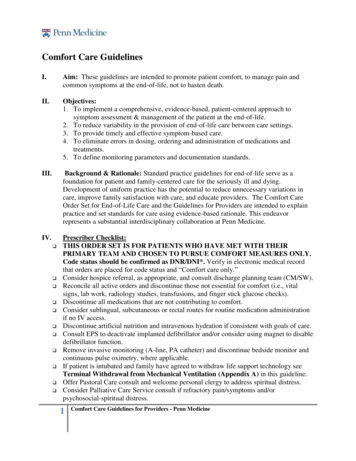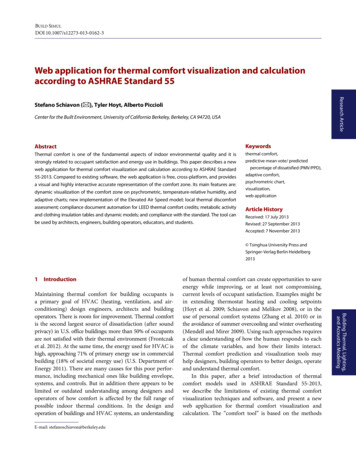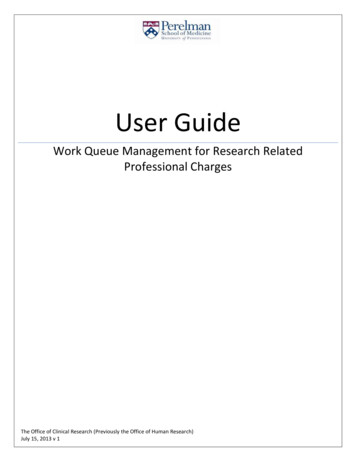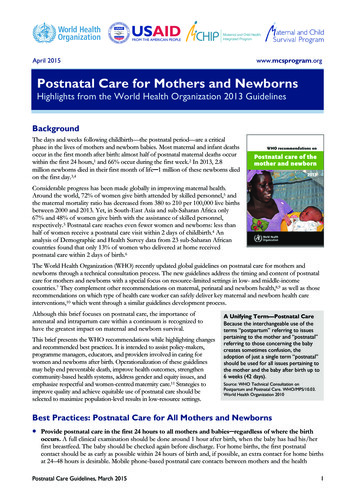
Transcription
Comfort Care GuidelinesI.Aim: These guidelines are intended to promote patient comfort, to manage pain andcommon symptoms at the end-of-life, not to hasten death.II.Objectives:1. To implement a comprehensive, evidence-based, patient-centered approach tosymptom assessment & management of the patient at the end-of-life.2. To reduce variability in the provision of end-of-life care between care settings.3. To provide timely and effective symptom-based care.4. To eliminate errors in dosing, ordering and administration of medications andtreatments.5. To define monitoring parameters and documentation standards.III.Background & Rationale: Standard practice guidelines for end-of-life serve as afoundation for patient and family-centered care for the seriously ill and dying.Development of uniform practice has the potential to reduce unnecessary variations incare, improve family satisfaction with care, and educate providers. The Comfort CareOrder Set for End-of-Life Care and the Guidelines for Providers are intended to explainpractice and set standards for care using evidence-based rationale. This endeavorrepresents a substantial interdisciplinary collaboration at Penn Medicine.IV. Prescriber Checklist:THIS ORDER SET IS FOR PATIENTS WHO HAVE MET WITH THEIRPRIMARY TEAM AND CHOSEN TO PURSUE COMFORT MEASURES ONLY.Code status should be confirmed as DNR/DNI*. Verify in electronic medical recordthat orders are placed for code status and “Comfort care only.”Consider hospice referral, as appropriate, and consult discharge planning team (CM/SW).Reconcile all active orders and discontinue those not essential for comfort (i.e., vitalsigns, lab work, radiology studies, transfusions, and finger stick glucose checks).Discontinue all medications that are not contributing to comfort.Consider sublingual, subcutaneous or rectal routes for routine medication administrationif no IV access.Discontinue artificial nutrition and intravenous hydration if consistent with goals of care.Consult EPS to deactivate implanted defibrillator and/or consider using magnet to disabledefibrillator function.Remove invasive monitoring (A-line, PA catheter) and discontinue bedside monitor andcontinuous pulse oximetry, where applicable.If patient is intubated and family have agreed to withdraw life support technology seeTerminal Withdrawal from Mechanical Ventilation (Appendix A) in this guideline.Offer Pastoral Care consult and welcome personal clergy to address spiritual distress.Consider Palliative Care Service consult if refractory pain/symptoms and/orpsychosocial-spiritual distress.1Comfort Care Guidelines for Providers - Penn Medicine
*Evaluate each patient case individually as extubation may not be appropriate for every patient on comfort care.V.Nursing Orders: Comfort Care Measures VI.Assess patient comfort q15-30 mins initially for pain, dyspnea, secretions, delirium/agitation,anxiety/fear and nausea/vomiting, constipation, and fever.Once comfort achieved, assess above symptoms q1hr and PRN.Vital signs (blood pressure, heart rate, temperature) q24hr and PRN.Oral care as needed to promote comfort/moisturizing.Turn and reposition as needed for comfort.For patients experiencing dyspnea, a fan in the room can help relieve symptom.Identify room as using entity-specific signage.Silence any room (monitor/bed) alarms.Remove external monitoring devices not necessary for comfort (ie: monitors, blood pressure cuff,telemetry leads, sequential compression devices, etc.).Liberalize visitation and prepare the room for family/friends.Assess family for psychosocial needs for bereavement and funeral arrangements, considerconsulting Social Work or Pastoral Care and welcome personal clergy to address spiritualdistress.Offer bereavement tray (call dietary to order).Family members may wish to participate in post mortem care for personal or religious reasons.Symptom Assessment & Managementa) Pain For all assessments, document pain using the one or more of the following.o Pain scale (0-10)o Behavioral Pain Scaleo And/or nonverbal signs of pain (grimacing, furrowed brow, guarding, etc.) If patient is comfortable, assess pain at least hourly and as needed. If patient is uncomfortable, bolus and document pain at least every 15 minutes whileestablishing comfort. Document pain score with each administration/titration of medications. Route of administration:o Enteral tube access: consider liquid formulation.o Difficulty swallowing: consider conversion to sublingual (SL), buccal, orintravenous (IV) administration.o No IV access: consider buccal, SL or subcutaneous (SC) administration.Select one of the following opioids: MORPHINE – Refer to APPENDIX B: Morphine Initiation and Titration forComfort Care HYDROMORPHONE – Refer to APPENDIX C: Hydromorphone Initiation andTitration for Comfort Care FENTANYL – Refer to APPENDIX D: Fentanyl Initiation and Titration forComfort Care2Comfort Care Guidelines for Providers - Penn Medicine
b) Dyspnea Management For all assessments, document dyspnea using the one or more of the following.o Patient/clinician-reported dyspnea using 0-10 scaleo Use of accessory muscleso RR 35/min. If patient is comfortable, assess dyspnea at least hourly and as needed. If patient is uncomfortable, bolus and document assessment at least every 15 minuteswhile establishing comfort. Document dyspnea assessment with each administration/titration of medications. Use opioid bolus and continuous titration (see respective titration charts found inAppendices A, B & C) to decrease dyspnea and alleviate associated symptoms. If anxiety is contributing to respiratory issues, consider lorazepam (see APPENDIX E:Lorazepam Initiation and Titration for Comfort Care). Continue nebulizer treatments if previously helpful to patient. If pleural drain in place, maintain and access for comfort.c) Anxiety For all assessments, document anxiety using:o Patient/clinician-reported anxiety using 0-10 scale If patient is comfortable, assess anxiety at least hourly and as needed. If patient is uncomfortable, bolus and document assessment at least every 30 minuteswhile establishing comfort. Document assessment with each administration/titration of medications. Consider anxiolytic:o Initial management: Lorazepam 0.5 mg PO/IV q 30 min as neededo For refractory symptoms see APPENDIX E: Lorazepam Initiation andTitration for Comfort Cared) Delirium/Agitation/Restlessness Evaluate and document delirium via CAM/CAM-ICU or unit standard q 12hrs and asneeded. Evaluate and document agitation via RASS q 4hro Non-pharmacologic: Remove restraints and discontinue order if family and/orcare providers are at the bedside and able to maintain patient safety. Pharmacologico Already on antipsychotic: Continue as scheduled, but discontinue EKG/labs. If not able to take orals, convert patient to IV haloperidol (maximumone-time dose of 10 mg). Refer to “Pain Agitation DeliriumGuideline.”o Not on antipsychotic: Initiate haloperidol 1-2 mg IV bolus as needed foragitation/restlessness. May repeat x1 in 30 minutes after first dose,3Comfort Care Guidelines for Providers - Penn Medicine
then continue q1hr as needed to resolution of agitation; total daily dosenot to exceed 30 mg for severe agitation or delirium.Persistent agitation: consider scheduling 1-2 mg of haloperidol on a q6hr schedulee) Nausea and Vomiting Evaluate and document for presence/absence of:o Patient-reported nausea/vomiting Initial management:o Prochlorperazine 10 mg PO/IV q 6hr as neededo Prochlorperazine 25 mg rectal q 6hr as needed Persistent nausea or vomiting:o Schedule initial anti-emetico Consider addition of: Ondansetron 8 mg IV q 8hr OR Ondansetron ODT 8 mg SL q 8hr Lorazepam 0.5 mg PO/IV q 4hr as needed Decreased gastrointestinal motility:o Metoclopramide 10mg PO/IV q 6hrf) Secretions Oral suction only for comfort. Glycopyrrolate 0.2 mg IV q 2hr as needed Hyoscyamine 0.125 mg sublingual q 4hr as needed (max daily dose 1.5 mg) Scopolamine patch q 72hr if life expectancy 24hrsg) Constipation If no bowel movement for 3 days, rule out obstruction with KUB if clinicallyappropriate and consistent with goals of care. No suspected obstruction:o Senna 8.6mg 2 tablets PO q HSo Difficulty swallowing or enteral tube access, consider liquid formulation. Obstruction or no oral access:o Bisacodyl 10mg suppository PR dailyh) Fever Acetaminophen 650mg PO/PR q 4hr PRN Difficulty swallowing or enteral tube access, consider liquid formulation. Ibuprofen 400 mg PO q 6hr PRN Ketorolac 15 mg IV q 6hr PRN (limit to 5 days)4Comfort Care Guidelines for Providers - Penn Medicine
Authors:Laura Dingfield, MDAnessa Foxwell, CRNP ACHPNRachel Klinedinst, CRNP ACHPNRebecca Stamm, MSN RN CCNS CCRNTanya Uritsky, PharmD BCPS, CPEUpdates June 2018 approved by Palliative Care Director UPHS; Pharmacy & Therapeutics HUPUpdates January 2016 approved by: Palliative Care Director HUP/PPMC; Pharmacy & Therapeutics PPMC/HUPApproval by the Pharmacy & Therapeutics - HUP (March 2013)Additional contributors/approvals included (May 2013): CMO/CNO council; Critical Care Collaborative;HUP, PPMC, PAH leadership/providers for critical care, palliative care and hospicePrevious Contributors: Megan Carr-Lettieri, MSN ACNP-BC CCRN, Jill Gehman, MHA BSN RN, TereseKornet, MSN RN, Jessica Palakshappa, MD Barbara Reville, DNP ACHPN, Andy Ross, MA RRT, DonnamarieSchuele, RN, Melissa Scott MSN RN CHPN, Hank Smith, RRT5Comfort Care Guidelines for Providers - Penn Medicine
VII.References1. Critical Care Medicine: Recommendations for end-of-life care in the intensive care unit: Aconsensus statement by the American College of Critical Care Medicine. March 2008. Volume36(3), pp 953-9632. Ross, M (2008). Implementing a bereavement program. Critical Care Nurse, 28(6) 88-89.3. Toevs, C & Whitehead,P. (2008). Palliative Medicine and Family Support in the ICU. Society ofCritical Care Medicine Newsletter Critical Connections 1 847 827 6869.4. BMJ Group (2008). Putting evidence into practice: Palliative Care.5. Freeman B. CARES: An acronym organized tool for the care of the dying. J of Hospice andPalliative nursing, 2013;15(3):147-153.6. Cook D and Rocker G. Dying with Dignity in the ICU. N Engl J Med 2014; 370: 2506-14.7. Jarabek BR, et al. Use of palliative care order set to improve resident comfort with symptommanagement in palliative care. Palliative Medicine 2008; 22: 343-3498. Campbell ML. Assessing respiratory distress when the patient cannot report dyspnea. Nurs ClinNorth Am. 2010;45(3):363-373. cnur.2010.03.001.9. Ely EW, Inouye SK, Bernard GR, et al. Delirium in mechanically ventilated patients: Validityand reliability of the confusion assessment method for the intensive care unit (CAM-ICU). JAMA.2001;286(21):2703-2710.10. Puntillo KA, Neuhaus J, Arai S, et al. Challenge of assessing symptoms in seriously ill intensivecare unit patients: Can proxy reporters help? Critical Care Medicine. 2012;40(10):2760-2767.11. Rubenfeld GD, Crawford SW. Principles and practice of withdrawing life-sustaining treatment inthe ICU. In: Curtis JR, Rubenfeld GD, eds. Managing death in the intensive care unit: Thetransition from cure to comfort. New York: Oxford; 2001:127-148.12. Treece P. Standardized order sets for end of life care. J Hosp Palliat Nurs. 2007;9(2):70-71.13. Walker KA, Nachreiner D, Patel J, Mayo RL, Kearney CD. Impact of standardized palliative careorder set on end-of-life care in a community teaching hospital. J Palliat Med. 2011;14(3):281286.14. Kayser JB, Uritsky TJ, Lanken P. Appendix C. Palliative Drug Therapy for Terminal Withdrawalof Mechanical Ventilation. In: Lanken et al, The ICU Manual 2nd ed. Elsevier; 2014. p989.15. Bender MA, Hurd, C, Solvang N, Colagrossi K, Matsuwaka D, Curtis JR. A new generation ofcomfort care order sets: Aligning protocols with current principles. J Palliat Med.2017;20(9):922-929. DOI: 10.1089/jpm.2016.05496Comfort Care Guidelines for Providers - Penn Medicine
VIII. AppendixesAppendix A: Terminal Withdrawal from Mechanical VentilationDevelop plan in conjunction with critical care MD/NP/RN, respiratory therapist, and patient’sfamily about approach and plan for removal of endotracheal tube. Consider two methods:1. Stepwise: Decrease in ventilatory support before removing endotracheal tubea. If the patient is hypoxic and severe dyspnea is anticipated upon withdrawal ofvent support, consider stepwise decrease in ventilator support and discontinuationof vasopressors first to reduce or eliminate respiratory drive.2. Immediate extubation: Immediate withdrawal of ventilatory support and endotrachealtube on current settingsa. If the patient is in shock/cardiac failure, consider immediate extubation just afterdiscontinuing vasopressors.Additional considerations: Place order for extubation (embedded in Comfort Care Order Set). Discuss timing of vasopressor discontinuation. Discontinue IV hydration and enteral feeding. Ensure no paralytic effect (document reversal of paralytic) before starting process. If the endotracheal tube is left in for clinical reasons or family request, considerusing the ventilator settings below (to avoid continuous alarming), once symptomsof dyspnea and discomfort have been alleviated by opioid titration:o Change mode of ventilation to assist controlo Reduce set respiratory rate to 2 breaths/mino Reduce tidal volume to 1/2 current setting (dead space)o Reduce Peak Flow to appropriate levelo Set apnea interval to 60 secondso Set low expiratory minute volume alarm to zero L/mino Set low expiratory tidal volume alarm to 100 ml below set tidalo Set pressure sensitivity to - 2 cm H2O (don’t use flow sensitivity as auto cyclingcan occur) o Maintain previous PEEP level (PEEP may be increased if clinically indicated)Educate family about common signs and symptoms during life support withdrawal.Offer time for family to perform ceremony, ritual, Pastoral Care visit, or prayers.Assess need to contact Gift of Life for organ donation as per unit protocol.Initiate medication administration 30 minutes prior to ventilator wean or withdrawal.All patients should be comfortable based on RASS, lack of dyspnea, tachycardia andtachypnea prior to ventilator wean or withdrawal.Bolus opioids /or benzodiazepine to achieve comfort between decreases in ventilatorysupport and following withdrawal.Assess patient for anxiety or agitation with RASS. If needed, administer benzodiazepineas previously described.7Comfort Care Guidelines for Providers - Penn Medicine
Appendix B: Morphine Initiation and Titration for Comfort CareMorphine Initiation: Comfort care for an opioid naïve patientPRN BolusStep 1Administer Morphine 2 mg IV x 1 If symptoms persist after 10 min repeat Morphine 2 mg IV bolus x 1 If Morphine 2 mg IV x2 in 20 min without symptom control, go to Step 2 If controlled*, continue Morphine 2 mg IV q 10 min PRNStep 2Administer Morphine 4 mg IV x 1 If symptoms persist after 10 min, repeat Morphine 4 mg IV bolus x 1 If Morphine 4 mg IV x2 in 20 min without symptom control, go to Step 3 If controlled*, continue Morphine 4 mg IV q 10 min PRNStep 3Administer Morphine 6 mg IV x 1 Is symptoms persist after 10 min, repeat Morphine 6 mg IV bolus x 1 If Morphine 6 mg IV x2 in 20 min without symptom control, goto the “Morphine: Titration of comfort care infusion” chartand start at Step 1 & bolus dose with the initiation of aMorphine infusion If controlled*, continue Morphine 6 mg IV q 10 min PRNInfusion DoseNo Infusion.Morphineinfusionshould notbe initiatedbeforeStep 3.RELY ON FREQUENT BOLUSING TO ACHIEVE RAPID AND EFFECTIVE SYMPTOM CONTROL.*See below for symptom monitoring parameters.* Symptom Monitoring ParametersPAIN – Pain scale (0-10), Behavioral Pain Scale, and/or nonverbal signs of painDYSPNEA – Patient/clinician-reported dyspnea scale (0-10); RR 35, use of accessory musclesOPIOID-TOLERANT PATIENTSOn current intermittent opioid (Morphine): Calculate the total daily dose in the previous 24 hours (include bothIV and PO – converted to IV equivalents). Divide by 24 to determine initial hourly dose and then refer to theTitration of Comfort Care Infusion chart for corresponding bolus and titration. Consider consultation withPharmacist for assistance.On current infusion opioid (Morphine): If patient is comfortable, maintain intravenous infusion at current dose. Ifpatient is uncomfortable, bolus every 10 minutes until comfortable and follow the Titration of Comfort CareInfusion chart.8Comfort Care Guidelines for Providers - Penn Medicine
Morphine: Titration of comfort care infusionIF YOU FEEL THE NEED TO TITRATE THE INFUSION MORE FREQUENTLY THAN 3 TIMES IN 24 HOURS,PLEASE CALL THE COVERING PROVIDER AND/OR THE PALLIATIVE CARE SERVICE FOR ASSISTANCE.PRN BolusInfusion DoseStep 1Administer Morphine 6 mg IV x 1 and q 10 min PRN If symptoms persist after 10 min, repeat 6 mg IV bolus If uncontrolled after bolus x 2 in 20 minutes – go to step 2Morphine 3 mg/hourStep 2Administer Morphine 8 mg IV x 1 and q 10 min PRNIf requiring hourly boluses over a 4-hour period, consider going on to step 3Morphine 3 mg/hourDO NOT TITRATE INFUSION RATE MORE FREQUENTLY THAN EVERY 4 HOURS.Step 3Administer Morphine 8 mg IV x 1 and q 10 min PRN If symptoms persist after 10 min, repeat 8 mg IV bolus If uncontrolled after bolus x 2 in 20 minutes – go to step 4Morphine 5 mg/hourStep 4Administer Morphine 10 mg IV x 1 q 10 min PRNIf requiring hourly boluses over a 4-hour period, consider going on to step 5Morphine 5 mg/hourDO NOT TITRATE INFUSION RATE MORE FREQUENTLY THAN EVERY 4 HOURS.Step 5Administer Morphine 10 mg IV x 1 and q 10 min PRN If symptoms persist after 10 min, repeat 10 mg IV bolus If uncontrolled after bolus x 2 in 20 minutes – go to step 6Morphine 8 mg/hourStep 6Administer Morphine 12 mg IV x 1 q 10 min PRNIf requiring hourly boluses over a 4-hour period, consider going on to step 7Morphine 8 mg/hourDO NOT TITRATE INFUSION RATE MORE FREQUENTLY THAN EVERY 4 HOURS.Step 7Administer Morphine 12 mg IV x 1 and q 10 min PRN If symptoms persist after 10 min, repeat 12 mg IV bolus If uncontrolled after bolus x 2 in 20 minutes – go to step 8Morphine 12 mg/hourStep 8Administer Morphine 16 mg IV x 1 and q 10 min PRNIf requiring hourly boluses over a 4-hour period, consider going on to step 9Morphine 12 mg /hourBefore Step 9, call covering provider to reassess patient; consider palliative care consult.Step 9Administer Morphine 16 mg IV x 1 and q 10 min PRN If symptoms persist after 10 min, repeat 16 mg IV bolus If uncontrolled after bolus x 2 in 20 minutes – go to step 10Morphine 16 mg/hourStep 10Administer Morphine 20 mg IV x 1 and q 10 min PRNIf requiring hourly boluses over a 4-hour period, consider going on to step 11Morphine 16 mg/hourDO NOT TITRATE INFUSION RATE MORE FREQUENTLY THAN EVERY 4 HOURS.Step 11Administer Morphine 20 mg IV x 1 and q 10 min PRN If symptoms persist after 10 min, repeat 20 mg IV bolus If uncontrolled after bolus x 2 in 20 minutes – go to step 12Morphine 20 mg/hourStep 12Administer Morphine 24 mg IV x 1 and q 10 min PRN Call palliative care if symptoms are still uncontrolledMorphine 20 mg/hourAt any step, for very difficult to control symptoms or patient exhibiting signs of opioid toxicity, consider rotation toalternative opioid and/or palliative care consultation.9Comfort Care Guidelines for Providers - Penn Medicine
Appendix C: Hydromorphone Initiation and Titration for Comfort CareHydromorphone Initiation: Comfort care for an opioid naïve patientPRN BolusStep 1Administer Hydromorphone 0.4 mg IV x 1 If symptoms persist after 10 min repeat Hydromorphone 0.4 mg IV x 1 If Hydromorphone 0.4 mg IV x2 in 20 min without symptom control, go toStep 2 If controlled*, continue Hydromorphone 0.4 mg IV q 10 min PRNStep 2Administer Hydromorphone 0.8 mg IV x 1 If symptoms persist after 10 min, repeat Hydromorphone 0.8 mg IV x 1 If Hydromorphone 0.8 mg IV x2 in 20 min without symptom control, go toStep 3 If controlled*, continue Hydromorphone 0.8 mg IV q 10 min PRNStep 3Administer Hydromorphone 1.2 mg IV x 1 Is symptoms persist after 10 min, repeat Hydromorphone 1.2 mg IV x 1 If Hydromorphone 1.2 mg IV x2 in 20 min without symptomcontrol, go to the “Hydromorphone: Titration of comfort careinfusion” chart and start at Step 1 & bolus dose with theinitiation of a Hydromorphone infusion If controlled*, continue Hydromorphone 1.2 mg IV q 10 min PRNInfusion DoseNo Infusion.Hydromorphoneinfusion shouldnotbe initiatedbeforeStep 3.RELY ON FREQUENT BOLUSING TO ACHIEVE RAPID AND EFFECTIVE SYMPTOM CONTROL.*See below for symptom monitoring parameters.* Symptom Monitoring ParametersPAIN – Pain scale (0-10), Behavioral Pain Scale, and/or nonverbal signs of painDYSPNEA – Patient/clinician-reported dyspnea scale (0-10); RR 35, use of accessory musclesOPIOID-TOLERANT PATIENTSOn current intermittent opioid (Hydromorphone): Calculate the total daily dose in the previous 24 hours (includeboth IV and PO – converted to IV equivalents). Divide by 24 to determine initial hourly dose and then refer to theTitration of Comfort Care Infusion chart for corresponding bolus and titration. Consider consultation withPharmacist for assistance.On current infusion opioid (Hydromorphone): If patient is comfortable, maintain intravenous infusion at currentdose. If patient is uncomfortable, bolus every 10 minutes until comfortable and follow the Titration of ComfortCare Infusion chart.10Comfort Care Guidelines for Providers - Penn Medicine
Hydromorphone: Titration of comfort care infusionIF YOU FEEL THE NEED TO TITRATE THE INFUSION MORE FREQUENTLY THAN 3 TIMES IN 24 HOURS,PLEASE CALL THE COVERING PROVIDER AND/OR THE PALLIATIVE CARE SERVICE FOR ASSISTANCE.PRN BolusInfusion DoseStep 1Administer Hydromorphone 1.2 mg IV x 1 and q 10 min PRN If symptoms persist after 10 min, repeat 1.2 mg IV bolus If uncontrolled after bolus x 2 in 20 minutes - go to step 2Hydromorphone0.5 mg/hrStep 2Administer Hydromorphone 1.6 mg IV x 1 and q 10 min PRNIf requiring hourly boluses over a 4-hour period, consider going on to step 3Hydromorphone0.5 mg/hrDO NOT TITRATE INFUSION RATE MORE FREQUENTLY THAN EVERY 4 HOURS.Step 3Administer Hydromorphone 1.6 mg IV x 1 and q 10 min PRN If symptoms persist after 10 min, repeat 1.6 mg bolus If uncontrolled after bolus x 2 in 20 minutes – go to step 4Hydromorphone0.8 mg/hrStep 4Administer Hydromorphone 2 mg IV q 10 min PRNIf requiring hourly boluses over a 4-hour period, consider going on to step 5Hydromorphone0.8 mg/hrDO NOT TITRATE INFUSION RATE MORE FREQUENTLY THAN EVERY 4 HOURS.Step 5Administer Hydromorphone 2 mg IV x 1 and q 10 min PRN If symptoms persist after 10 min, repeat 2 mg bolus If uncontrolled after bolus x 2 in 20 minutes – go to step 6Hydromorphone1.4 mg/hrStep 6Administer Hydromorphone 3 mg IV q 10 min PRNIf requiring hourly boluses over a 4-hour period, consider going on to step 7Hydromorphone1.4 mg/hrDO NOT TITRATE INFUSION RATE MORE FREQUENTLY THAN EVERY 4 HOURS.Step 7Administer Hydromorphone 3 mg IV x 1 and q 10 min PRN If symptoms persist after 10 min, repeat 3 mg bolus If uncontrolled after bolus x 2 in 20 minutes – go to step 8Hydromorphone2 mg/hrStep 8Administer Hydromorphone 4 mg IV q 10 min PRNIf requiring hourly boluses over a 4-hour period, consider going on to step 9Hydromorphone2 mg/hrBefore Step 9, call covering provider to reassess patient; consider palliative care consult.Step 9Administer Hydromorphone 4 mg IV x 1 q 10 min PRN If symptoms persist after 10 min, repeat 4 mg bolus If uncontrolled after bolus x 2 in 20 minutes – go to step 10Hydromorphone3 mg/hrStep 10Administer Hydromorphone 6 mg IV q 10 min PRNIf requiring hourly boluses over a 4-hour period, consider going on to step 11Hydromorphone3 mg/hrDO NOT TITRATE INFUSION RATE MORE FREQUENTLY THAN EVERY 4 HOURS.Step 11Administer Hydromorphone 6 mg IV x 1 and q 10 min PRN If symptoms persist after 10 min, repeat 6 mg bolus If uncontrolled after bolus x 2 in 20 minutes - go to step 12Hydromorphone4 mg/hrStep 12Administer hydromorphone 8 mg IV x 1 and q 10 min PRN Call palliative care if symptoms are still uncontrolledHydromorphone4 mg/hrAt any step, for very difficult to control symptoms or patient exhibiting signs of opioid toxicity, consider rotation toalternative opioid and/or palliative care consultation.11Comfort Care Guidelines for Providers - Penn Medicine
Appendix D: Fentanyl Initiation and Titration for Comfort CareFentanyl Initiation: Comfort care for an opioid naïve patientPRN BolusStep 1Administer Fentanyl 25 mcg IV x 1 If symptoms persist after 10 min, repeat Fentanyl 25 mcg IV bolus x 1 If Fentanyl 25 mcg IV x2 in 20 min without symptom control, got to Step 2 If controlled*, continue Fentanyl 25 mcg IV q 10 min PRNStep 2Administer Fentanyl 37 mcg IV x 1 Is symptoms persist after 10 min, repeat Fentanyl 37 mcg IV bolus x 1 If Fentanyl 37 mcg IV x2 in 20 min without symptom control, go to Step 3Step 3Administer Fentanyl 50 mcg IV x 1 Is symptoms persist after 10 min, repeat Fentanyl 50 mcg IV bolus x 1 If Fentanyl 50 mcg IV x2 in 20 min without symptom control, go tothe “Fentanyl: Titration of comfort care infusion” chart and startat Step 1 & bolus dose with the initiation of a Fentanyl infusionIf controlled*, continue Fentanyl 50 mcg IV q 10 min PRNInfusion DoseNo Infusion.Fentanylinfusionshould not beinitiatedbefore Step 3.RELY ON FREQUENT BOLUSING TO ACHIEVE RAPID AND EFFECTIVE SYMPTOM CONTROL.*See below for symptom monitoring parameters* Symptom Monitoring ParametersPAIN – Pain scale (0-10), Behavioral Pain Scale, and/or nonverbal signs of painDYSPNEA – Patient/clinician-reported dyspnea scale (0-10); RR 35, use of accessory musclesOPIOID-TOLERANT PATIENTSOn current intermittent opioid (Fentanyl): Calculate the total daily dose in the previous 24 hours (include both IVand PO – converted to IV equivalents). Divide by 24 to determine initial hourly dose and then refer to the Titrationof Comfort Care Infusion chart for corresponding bolus and titration. Consider consultation with Pharmacist forassistance.On current infusion opioid (Fentanyl): If patient is comfortable, maintain intravenous infusion at current dose. Ifpatient is uncomfortable, bolus every 10 minutes until comfortable and follow the Titration of Comfort CareInfusion chart.12Comfort Care Guidelines for Providers - Penn Medicine
Fentanyl: Titration of comfort care infusionIF YOU FEEL THE NEED TO TITRATE THE INFUSION MORE FREQUENTLY THAN 3 TIMES IN 24 HOURS,PLEASE CALL THE COVERING PROVIDER AND/OR THE PALLIATIVE CARE SERVICE FOR ASSISTANCE.PRN BolusInfusion DoseStep 1Administer Fentanyl 50 mcg IV x 1 and q 10 min PRN If symptoms persist after 10 min, repeat 50 mcg IV bolus If uncontrolled after bolus x 2 in 20 minutes – go to step 2Fentanyl 25mcg/hourStep 2Administer Fentanyl 62 mcg IV x 1 and q 10 min PRNIf requiring hourly boluses over a 4-hour period, consider going on to step 3Fentanyl 25mcg/hourDO NOT TITRATE INFUSION RATE MORE FREQUENTLY THAN EVERY 4 HOURSStep 3Administer Fentanyl 62 mcg IV x 1 and q 10 min PRN If symptoms persist after 10 min, repeat 62 mcg IV bolus If uncontrolled after bolus x 2 in 20 minutes – go to step 4Fentanyl 37mcg/hourStep 4Administer Fentanyl 75 mcg IV x 1 and q 10 min PRNIf requiring hourly boluses over a 4-hour period, consider going on to step 5Fentanyl 37mcg/hourDO NOT TITRATE INFUSION RATE MORE FREQUENTLY THAN EVERY 4 HOURSStep 5Administer Fentanyl 75 mcg IV x 1 and q 10 min PRN If symptoms persist after 10 min, repeat 75 mcg IV bolus If uncontrolled after bolus x 2 in 20 minutes – go to step 6Fentanyl 50mcg/hourStep 6Administer Fentanyl 100 mcg IV q 10 min PRNIf requiring hourly boluses over a 4-hour period, consider going on to step 7Fentanyl 50mcg/hourDO NOT TITRATE INFUSION RATE MORE FREQUENTLY THAN EVERY 4 HOURSStep 7Administer Fentanyl 100 mcg IV x 1 and q 10 min PRN If symptoms persist after 10 min, repeat 100 mcg IV bolus If uncontrolled after bolus x 2 in 20 minutes – go to step 8Fentanyl 75mcg/hourStep 8Administer Fentanyl 150 mcg IV x 1 and q 10 min PRNIf requiring hourly boluses over a 4-hour period, consider going on to step 9Fentanyl 75mcg/hourBefore Step 9, call covering provider to reassess patient; consider palliative care consult.Step 9Step10Administer Fentanyl 150 mcg IV x 1 and q 10 min PRN If symptoms persist after 10 min, repeat 150 mcg IV bolus If uncontrolled after bolus x 2 in 20 minutes – go to step 10Fentanyl 100mcg/hourAdminister Fentanyl 200 mcg IV x1 and q 10 min PRNIf requiring hourly boluses over a 4-hour period, consider going on to step 11Fentanyl 100mcg/hourDO NOT TITRATE INFUSION RATE MORE FREQUENTLY THAN EVERY 4 HOURSStep11Administer Fentanyl 200 mcg IV q 10 min PRN If symptoms persist after 10 min, repeat 200 mcg IV bolus If uncontrolled after bolus x 2 in 20 minutes – go to step 12Fentanyl 150mcg/hourStep12Administer Fentanyl 250 mcg IV x 1 and q 10 min PRN Call palliative care if symptoms are still uncontrolledFentanyl 150mcg/hourAt any step, for very difficult to control symptoms or patient exhibiting signs of opioid toxicity, considerrotation to alternative opioid and/or palliative care consultation.13Comfort Care Guidelines for Providers - Penn Medicine
Appendix E: Lorazepam Initiation and Titration for Comfort CareLorazepam Initiation: comfort care for a benzodiazepine-naïve patientPRN BolusStep 1Step 2Administer Lorazepam 0.5 mg IV x 1 If symptoms persist after 30 min repeat lorazepam 0.5 mg IV bolus x 1 If Lorazepam 0.5 mg IV x 2 in 1 hour without symptom control, go to Step 2 If controlled*, continue lorazepam 0.5 mg IV q 30 min PRNAdminister Lorazepam 1 mg IV x 1 If symptoms persist after 30 min repeat Lorazepam 1 mg IV bolus x 1 If Lorazepam 1 mg IV x 2 in 1 hour without symptom control, schedule 1 mg IVq 4h and continue lorazepam 1 mg IV q 30 min
2 Comfort Care Guidelines for Providers - Penn Medicine *Evaluate each patient case individually as extubation may not be appropriate for every patient on comfort care. V. Nursing Orders: Comfort Care Measures Assess patient comfort q15-30 mins initially for pain, dyspnea, secretions, delirium/agitation, a










